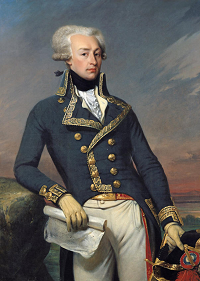The Battle of Brandywine: — Part 9 of 10
Lafayette Is "Honoured"

Portrait of Gilbert Motier the Marquis De La Fayette as a Lieutenant General, 1791
Joseph Désiré Court, 1834
At this point Lafayette rode up and did all he could to make the men charge at the point of a bayonet but the Americans, little used to this sort of fighting did not care to do so, and this brigade fled like the rest of the army." Then, Amidst the confusion, Lafayette was wounded, as he would recount later in a letter to his wife: "the English honoured me with a musket ball, which slightly wounded me in the leg."
Greene opened his ranks to let the retreating Americans pass through and then re-formed his lines. Fierce fighting now took place in the area known as Sandy Hill. Charges and countercharges followed.
Back at Chadd's Ford Kynphausen Launches His Attack
While the Americans were fighting the British near Dilworth, they could hear cannon fire from the vicinity of Chadd's Ford. Knyphausen was attacking Wayne. If Wayne gave way, the British under Knyphausen would have a clear path to Greene's troops fighting the northern attackers.
Knyphausen had begun bombarding the Americans across the creek with heavy artillery. The Prussian general was supposed to hold his attack until he heard the sound of Howe firing two cannon shots which was the signal that the northern troops had forded the river successfully. Regardless, at 4:00 P.M., Knyphausen began a frontal attack without the signal.
Fortunately for Knyphausen, American brigades under Generals Green and Nash had just been sent north to reinforce the American lines at Birmingham. Knyphausen sent his men across the Brandywine at several different fording spots, with four regiments alone crossing at Brinton's Ford. Knyphausen's main column pushed through at Chadd's Ford in the face of heavy American resistance. A smaller British force moved south, and crossed the creek probably at Gibson's Ford, which threatened the American militia posted farther south at Pyle's Ford.
The Americans fought with verve — despite being outnumbered. They might have been able to endure the attack had not another British regiment — who had gotten lost earlier in the day at Birmingham Hill — entered the fray. These British Guards and Grenadier Brigades were supposed have part of the British force that attacked Sullivan's second line of defense at Battle Hill. Instead, they became tangled and lost in the thickets of Wistar's Woods, which allowed Sullivan's men to hold their ground longer than they might have.
After a couple hours, these lost troops emerged serendipitously to the rear of Wayne's artillery position. Now, Wayne had to shift some of his men to defend against this new menace.
The British pushed the outflanked Americans back to the Chad House where the Widow Chads remained — and staunchly defended her property.
Ultimately, the British got the best of Wayne's men in a spirited duel. Besieged by the bayonets of the British 71st Battalion and the Queens Rangers, the Americans turned tail toward Chester, leaving their artillery behind. Eleven guns were abandoned by the Americans including two cannon which had been captured from the Hessians during Washington's surprise attack of Trenton after crossing of the Delaware on Christmas Day 1776.
Among those besieging the British was Patrick Ferguson of Ferguson's Rifleman. It was near the Chadd House that the inventor of the breech-loading rifle was wounded, which may have had an effect on the war.



